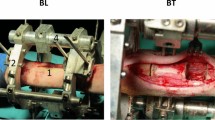Summary
Experimental physial distraction was carried out in the distal part of the femur in 45 two-month old lambs in order to study the basic mechanisms of lengthening as ell as the viability of the growth cartilage after using this method. The animals were divided into three groups (A, B and C), and each group into three subgroups (1, 2 and 3) according to the rate of distraction used (2 mm/day, 1 mm/day, 0.5 mm/day) and the time of sacrifice.
The results obtained show that the basic lengthening mechanisms consists, firstly, in the production of a fracture between the metaphysis and the epiphysis and, secondly, that the lower the distraction speed employed, the greater is the short-term and long-term viability of the growth cartilage. Optimum viability was observed at a distraction rate of 0.5 mm/day.
On this basis we conclude that in clinical practice physial distraction could be indicated for children at an early stage of skeletal growth and repeated later provided that the rate of distraction is kept within reasonable limits.
Résumé
Une étude expérimentale portant sur la distraction épiphysaire au niveau de l'extrémité distale du fémur a été réalisée chez 45 moutons âgés de 2 mois, dans le but d'étudier les mécanismes d'allongement ainsi que la vitalité du cartilage de croissance. Les animaux ont été divisés en trois groupes (A, B, C) et 9 sous-groupes (1, 2, 3) selon la vitesse de l'allongement (2 mm/jour, 1 mm, 0,5 mm) et la date à laquelle ils ont été sacrifiés.
Les résultats obtenus montrent que le mécanisme de base consiste dans la création d'une fracture épiphysodiaphysaire et, d'autre part, que plus la vitesse d'élongation est lente, plus le cartilage de croissance est viable à court et à long terme. Les meilleurs résultats furent obtenus à la vitesse de 0,5 mm/jour. On peut donc conclure qu'en pratique la distraction épiphysaire peut être indiquée chez les enfants dont l'âge osseux est bas, et qu'elle peut être répétée ultérieurement, à condition de maintenir la vitesse d'allongement dans des limites raisonnables.
Similar content being viewed by others
References
De Bastiani G, Aldegheri R, Renzi Brivio (1984) The treatment of fractures with a dynamic axial fixator. J Bone Joint Surg 66-B: 538–545
Bensahel H, Hugerin Ph, Biard JL (1983) L'allongement trans-épiphysaire du tibia. A propos d'un cas. Rev Chir Orthop 69: 245–247
Berchiche R, Wittek F (1983) Allongement du squelette jambier par épiphysiolyse-distraction. Traitement des inégalités des membres inférieurs. Acta Orthop Belg 49: 321–313
Eydelshtein BM, Udalova NI, Bochkarev GF (1973) Dynamics of reparative regeneration after lengthening by the method of distraction epiphysiolysis. Acta Chir Plast 15: 149–154
Fischenko PJ, Sadovefa VI, Karimova LF, Pilipenko NP (1976) Roentgenographic imaging of the regenerate formation in distraction epiphysiolysis. Ortop Traumatol Protez 37: 29–41
Fischenko PJ, Karimova LF, Philipenko NP (1976) Distraction epiphysiolysis in congenital shortening of lower extremities. Ortop Traumatol Protez 37: 44–62
Fishbane BM, Riley LH (1976) Continuous trans-physeal traction. A simple method of bone lengthening. Johns Hopkins Med J 138: 79–81
Fishbane BM, Riley LH (1978) Continuous transphyseal traction: Experimental observation. Clin Orthop 136: 120–124
Houghton GR, Duriez J (1980) Allongement tibial par élongation du cartilage de croissance tibial supérieur. Etude expérimentale chez le lapin. Rev Chir Orthop 66: 351–356
Ilizarov GA, Soybelman LM (1969) Some clinical and experimental data on the bloodless lengthening of lower limbs. Exp Khir Anes 4: 27–32
Ilizarov GA, Soybelman LM, Chirkova AM (1970) Some roentgenologic and morphological data on regeneration of bone tissue in experimental distraction epiphysiolysis. Ortop Traumatol Protez 31: 26–45
Jani L (1973) Tierexperimentelle Studie über Tibiaverlängerung durch Distraktionepiphyseolyse. Z Orthop 111: 627–630
Jani L (1975) Die Distraktionepiphyseolyse. Tierexperimentelle Studie zum Problem der Beinverlängerung. Z Orthop 113: 189–198
Letts RM, Meadows L (1978) Epiphysiolysis as a method of limb lengthening. Clin Orthop (Rel Res) 133: 230–245
Monticelli G, Spinelli R (1979) Personal communication. Giornate Italiane del Fiassatore Esterno. Venice (Italy), 1979).
Monticelli G, Spinelli R (1981) Allongement des membres par distraction épiphysaire. Rev Chir Orthop 67: 215–220
Monticelli G, Spinelli R (1981) Limb lengthening by epiphyseal distraction. Int Orthop (SICOT) 5: 85–90
Monticelli G, Spinelli R (1981) Distraction epiphysiolysis as a method of limb lengthening. I. Experimental study. Clin Orthop Rel Res 154: 256–261
Monticelli G, Spinelli R, Bonucci E (1981) Distraction epiphysiolysis as a method of limb lengthening. II. Morphologic investigations. Clin Orthop Rel Res 154: 262–273
Monticelli G, Spinelli R (1981) Distraction epiphysiolysis as a method of limb lengthening. III. Clinical applications. Clin Orthop Rel Res 154: 274–285
Noble J, Sledge CB, Walker PS, Diamond R, Stirratt CR, Sosman JL (1978) Limb lengthening by epiphysial distraction. J Bone Joint Surg 60-B: 139–140
Noble J, Diamond R, Stirratt CR, Sledge CB (1982) Breaking force of the rabbit growth plate and its application to epiphyseal distraction. Acta Orthop Scand 53: 13–16
Ogden JA (1982) Skeletal injury in the child. Ed Lea & Febiger. Philadelphia, pp 59–60
Ricciardi L (1984) Epifisiolisi distrazionale monocompartimentale. G Ital Ortop Traum 10: 57–61
Ring PA (1958) Experimental bone lengthening by epiphyseal distraction. Br J Surg 49: 169–173
Salter RB, Harris WR (1969) Injuries to the growth plate. In “The growth plate and its disorders”. Mercer Rang. Ed Williams and Wilkins, Baltimore p 133
Sledge CB, Noble J (1978) Experimental limb lengthening by epiphyseal distraction. Clin Orthop Rel Res 136: 111–119
Trueta J, Amato VP (1960) The vascular contribution to osteogenesis. III. Changes in the growth cartilage caused by experimentaly induced ischaemia. J Bone Joint Surg 42-B: 571–597
Wevdenskogo SP (1974) Distraction epiphysiolysis of crural bones. Ortop Traumatol Protez 10: 53–55
Zavijalov PV, Plaskin JT (1967) Elongation of crural bones in children using a method of distraction epiphysiolysis. Vest Khri Grekova 103: 67–82
Zavijalov PV, Plaskin JT (1968) Distraction epiphysiolysis in lengthening of the lower extremity in children. Khirurgija 44: 121–137
Author information
Authors and Affiliations
Rights and permissions
About this article
Cite this article
de Pablos, J., Villas, C. & Canadell, J. Bone lengthening by physial distraction. International Orthopaedics 10, 163–170 (1986). https://doi.org/10.1007/BF00266203
Issue Date:
DOI: https://doi.org/10.1007/BF00266203




